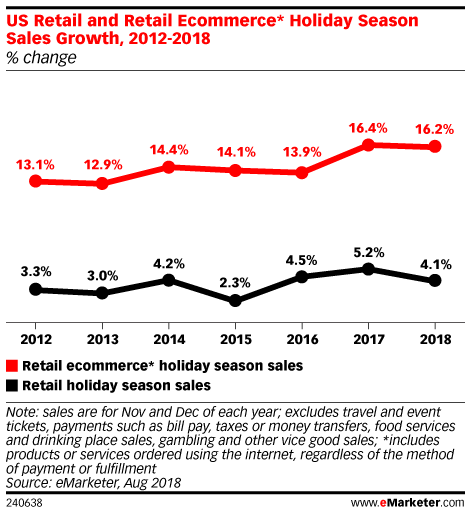Set a reminder on your phone to shop online or head to your local market, the retail industry’s biggest event is here!
Yes, holiday shopping season is knocking the door and will be offering doorbuster deals! Almost every retailer and shopper is excited about Black Friday, Cyber Monday, and Thanksgiving festivities along with the biggest holiday shopping season. The end of November is a time of biggest discounts and deals from biggest retail organizations and brands including Google, Walmart, Amazon, Best Buy, and Microsoft.
This post is for every retailer who wants to boost their sales in this festive season. It covers data, trends, consumer behavior, strategies, market insights, and focus on an omnichannel strategy that can help you win the battle of retail.
Let’s get started!
Before going further, several dates you need to consider:
- Thanks, Giving – November 22
- Black Friday – November 23 (One of the biggest sale event in the US)
- Cyber Monday – November 26 (the Biggest retail event of the entire year)
- Green Monday – December 10 (second-biggest online holiday shopping)
- Free Shipping Day – December 14 (United States)

Holiday Shopping 2018: Predictions And Market Trends You Need To Pay Attention To
According to eMarketer, 2018 US holiday ecommerce sales are predicted to grow 16.2% to $123.39 billion.

According to the ‘Customers 2020 study by Walker, a customer intelligence consulting firm:
“Customer experience will overtake price and product as the key brand differentiator by the year 2020.”
According to Adobe’s 2017 online shopping report, last year Cyber Monday created a record as the largest online sales day in the US with $6.59 billion.
The holiday shopping season (November 1 to 27) drove a total of $50 billion in online revenue in 2017, a 16.8 percent increase than last year, according to this Adobe shopping data.
Adobe report says, Mobile set a new record representing 47.4 percent of visits (39.9 percent smartphones, 7.6 percent tablets) and 33.1 percent of revenue (24.1 percent smartphones, 9.0 percent tablets).
Statistics may continue to amaze and big growth in big markets continue to take over. But, to generate higher revenues in the holiday season, one needs to have groundbreaking strategies and strategic planning to boost holiday shopping season sales.
Recently, Alibaba’s Singles’ Day set a new record of $30.8 billion sales by focusing on an omnichannel strategy of retail that represents the omnipresence of brands – offline and online.
That proves that physical retail isn’t truly faded. In fact, it has started gaining popularity as a key strategy to increase sales.
If you can observe, the whole new class of retailers is emerging who not only shops online but visits physical stores more often. By January 2019, 90 percent of all retail will still be done in Physical stores. [Source]
“Until Amazon creates a drone that can cut your hair, there’s a physical and real reason to come to the store.”
– Mary Dillon, CEO, ULTA Beauty
Retail is all about the customer. It’s more than just the transaction, product, and payment, it’s all about the experience. Retailers are reinventing their business by having both, physical and online stores.
“Bricks And Clicks” Model Of Retail: Seamless Integration Of Physical And Digital Experiences
Retailers are paying more attention to consumer spending, habits, satisfaction, and behavior to provide them with the superior shopping experience. To achieve this, leading retailers are leveraging their physical stores to create more powerful strategies online.
I was reading all these reports that were down on retail brick and mortar, saying it’s all about online… I think brick and mortar is an amazing opportunity to use our stores and our store staffs as a vehicle to truly engage with the community in a way no other retailers are doing.
– Jim Brett, President, West Elm
You can also see that the retailers who started with online stores are now moving ahead with opening offline stores to understand their customers. (Example: Amazon Go).
It’s incredibly well-defined strategy to combine real-life shopping experience and digital touchpoints that overall creates a superior customer experience, and that’s the key to win customers’ heart.
Why Omnichannel?
In the age of e-commerce, many retail giants are leveling up their business strategy by opening a physical store that can create a memorable shopping experience.
Also, consider the below scenario:
- The customer can browse online and can get an in-store coupon to use Online purchase and in-store pickup
- Purchase later after browsing the product in-store
- Customer loyalty points can be increased via in-store purchase and online notifications
- Customer services can be better with the right omnichannel approach
How Retailers Can Create The Perfect Omnichannel Strategy?
Here are some of the factors that can help retailers to improve overall performance and boost sales.
-
Research and locate your target audience
You need to have a clear idea of where your customers are so that you can focus on specific channels. Make a thorough research about the platforms they’re using and know about the channels they generally prefer to shop.
For instance, you may realize that your customers are not using Etsy, you can avoid wasting money on that channel and focus on other profitable channels
The best way to find the popular channels for your business is by using Google Analytics. You will have a better insight into the channels that are the most effective to drive visitors to your website. You will have a proper idea about how the customers are learning about your business.
-
Engage your customers at every touch points
Whether you’re running a small Mom and Pop shop or a part of a large enterprise, you need to make every touchpoint shoppable.
Suppose the customer adds a product to their cart from your website/mobile app. Now they land on Facebook/Instagram/Pinterest, your product must appear on ‘suggested products’ based on that previous product history.
To make this happen, you can use eCommerce management platform to integrate your store directly with social media platforms enabling your customers back to your online store. With such connections between channels and online store, you can run promotional campaigns on social media to drive traffic to your site.
-
Bridge the gap between online and offline store
Today, customers expect a seamless experience from the brand online and in-store as well. Hence, retailers must aim for creating a smooth transition between both the stores.
For instance: You can opt for “Buy online pick in-store.” You can allow customers to place their orders online and then pick up from a brick-and-mortar store. This will provide enhanced customer experience because your customers can save much of the time.
Macy’s, for example, introduced a new e-commerce platform, their website not only generated $1billion rise in online sales but also influenced $5 billion worth of in-store sales. Macy’s store distribution centers supplemented the “Buy online Pickup in-store” program to bring customers into the stores.
-
Mobile Commerce
If you have been paying attention to the previous year stats, the share of shopping time spent on mobile increased by 5% from 2016 to 2017. According to the Adobe analytics, 45% of the website visits came from smart-phone.
Retailers can expect a stronger reliance on mobile in 2018.
Retailers must focus on mobile-optimized website, native apps and must offer push notifications about the latest sales. Make the use of beacon technology to let shoppers know about the deals in the proximity and provide personalized, on-the-go experience for the great customer satisfaction.
-
Same Day delivery
The undeniable winner of e-commerce technology in the holiday season 2017 was the same-day delivery provider. Apart from the Amazon pioneering in providing the great customer experience, retailers like Nordstrom and Walmart came up with the same day delivery to push their sales.
To cope up with the competition, retailers must think of providing same-day delivery. Brand’s reputation can be easily damaged due to a failed delivery or poor user experience. While the holiday comes once in a year, retailers must use modern technologies to provide seamless customer experience.
Use of Modern Technologies That Can Help Increase Sales:
- Incorporated chatbots that can ensure immediately and 24*7 customer service
- Use of machine learning algorithm to better serve customers by analyzing the habits, spending, and information
- Elimination of repetitive tasks by applying RPA( Robotic Process Automation)
- AI-powered conversations and voice assistance to manage customer service
- Faster, better, and personalized experience with the help of business intelligence
- Use of Augmented Reality/Virtual Reality to create immersive, influential experience that can attract customers
- Authenticity and integrity of brands across all the channels through secure, connected, and fast processes
- Secure payment gateways and strong social media presence to emboss the brand impact
Brands That Nailed It In Providing Omni-Channel Experience
Oasis
Oasis is a UK fashion retailer who is using their e-commerce site, mobile app, and brick-and-mortar store to provide the great user experience.
If a customer walks inside a store, they will find the sales associates armed with iPads providing on-the-spot, accurate and up-to-date product information. And the cherry on top, if some products are out of stock, the staff can instantly place an online order and have the item shipped directly to the home.
Moreover, shoppers can download Oasis app to complement their in-store and online shopping experience.
Macy’s
Growing overlap between shopping experience on the mobile application, in-stores; Macy’s is enabling shoppers to use the Macy’s app to sort the items that are available at a nearby store for those who prefer to purchase from the app and pick up in-store. In addition to it, users of the app can stay signed-in for up to 6 hours without re-entering their information.
“Our goal is to provide our shopper with the best experience in whatever way the customer chooses to interact with us: mobile, desktop, store or all of them together”
– R.B. Harrison, Chief Omnichannel Officer for Macy’s
It’s Just Beginning:
We hope that you’ve got a clear understanding about the insights and trends that can drive a significantly higher ROI.
What are your strategies for the holiday season 2018? Have you planned strategy that has all the aforementioned factors? Do you use any different strategy to lure your shoppers? You can tell us via the comments below.
This article was originally published on SPEC INDIA’s Blog:- here



